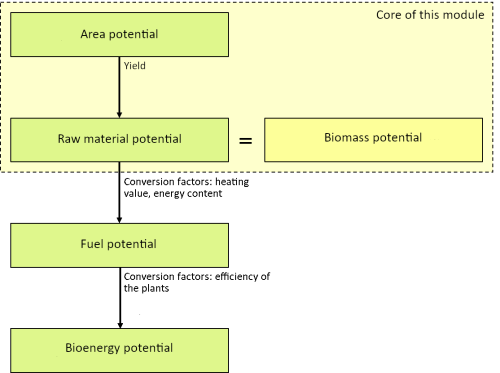Potential levels
When considering potential levels, a distinction is made between land, raw material, fuel and bioenergy potentials (Thrän and Pfeiffer 2013, pp. 39-40).
Potential levels in regard to a conversion pathway. Adapted from: Thrän and Pfeiffer 2013
The basis for calculating the potential of a biomass is often an area. The area potential shows on which area raw materials are cultivated or can be cultivated (e.g. energy crops, forestry). The raw material potential describes the amount of biogenic substances that (could) be accumulated on these areas, e.g. via the yield. In addition, the raw material potential can represent biomasses that have no direct spatial reference. The annual amount of cattle slurry in the administrative districts of Germany, for example, can be calculated, by multiplying the number of cattle per administrative district by the amount of slurry per animal. The raw material potential is typically expressed in tonnes of dry matter per year [tTM/a] or megagram dry matter [MgTM/a]. Information on the conversion between fresh and dry matter and Mg can be found in the Glossary. Technical conversion factors such as energy content, efficiency of conversion plants and conversion paths are taken into account for the fuel and bioenergy potential. The bioenergy potential reflects the proportion of final energy provided after conversion.
